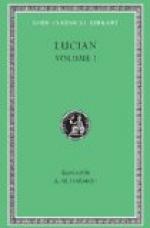Until this question is settled, the anomaly will continue of civilization and the reverse existing side by side. Some of the Indians have assumed the manners, dress, virtues and vices of their white neighbors, in which case they have generally dropped their old names and assumed something reasonable in their place. But many of the red men who adhere to tradition, and who object to innovation, still stick to the names given them in their boyhood. Thus, in traveling across the Indian Territory, Indians with such names as “Hears-Something-Everywhere,” “Knows-Where-He-Walks,” “Bear-in-the-Cloud,” “Goose-Over-the-Hill,” “Shell-on-the-Neck,” “Sorrel Horse,” “White Fox,” “Strikes-on-the-Top-of-the-Head,” and other equally far-fetched and ridiculous terms and cognomens.
Every one has heard of Chief “Rain-in-the-Face,” a characteristic Indian, whose virtues and vices have both been greatly exaggerated from time to time. A picture is given of this representative of a rapidly decaying race, and of the favorite pony upon which he has ridden thousands of miles, and which in its early years possessed powers of endurance far beyond what any one who has resided in countries removed from Indian settlements can have any idea or conception of.
CHAPTER VII.
COWBOYS—REAL AND IDEAL.
A Much Maligned Class—The Cowboy as he Is, and as he is Supposed to be—Prairie Fever and how it is Cured—Life on the Ranch Thirty Years Ago and Now—Singular Fashions and Changes of Costume—Troubles Encountered by would-be Bad Men.
Among the thoroughly American types of humanity, none is more striking or unique than the cowboy. This master of horsemanship and subduer of wild and even dangerous cattle, has been described in so many ways that a great difference of opinion exists as to what he was, and what he is. We give a picture of a cowboy of to-day, and will endeavor to show in what important respects he differs from the cowboy of fiction, and even of history.
Sensational writers have described the cowboy as a thoroughly bad man, and, moreover, as one who delights in the word “bad,” and regards it as a sort of diploma or qualification. Travelers over the region in which the cowboy used to be predominant give him a very different character, and speak of him as a hard-working, honest citizen, generous to a fault, courteous to women and aged or infirm men, but inclined to be humorous at the expense of those who are strong and big enough to return a joke, or resent it, if they so prefer.
We have spoken of the cowboy in two tenses: the present and the past. Strictly speaking, we should, perhaps, have only used one, for many of the best judges say that there is no such thing as a cowboy in this day and generation. He flourished in all his glory in the days of immense ranges, when there was an abundance of elbow room for both man and beast, and when such modern interferences with the




